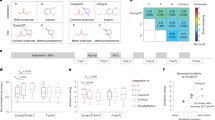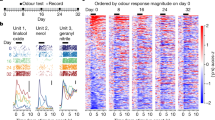Abstract
The categorial nature of sensory, cognitive and behavioural acts indicates that the brain classifies neuronal activity patterns into discrete representations. Pattern classification may be achieved by abrupt switching between discrete activity states of neuronal circuits, but few experimental studies have directly tested this. We gradually varied the concentration or molecular identity of odours and optically measured responses across output neurons of the olfactory bulb in zebrafish. Whereas population activity patterns were largely insensitive to changes in odour concentration, morphing of one odour into another resulted in abrupt transitions between odour representations. These transitions were mediated by coordinated response changes among small neuronal ensembles rather than by shifts in the global network state. The olfactory bulb therefore classifies odour-evoked input patterns into many discrete and defined output patterns, as proposed by attractor models. This computation is consistent with perceptual phenomena and may represent a general information processing strategy in the brain.
This is a preview of subscription content, access via your institution
Access options
Subscribe to this journal
Receive 51 print issues and online access
$199.00 per year
only $3.90 per issue
Buy this article
- Purchase on Springer Link
- Instant access to full article PDF
Prices may be subject to local taxes which are calculated during checkout




Similar content being viewed by others
References
Wang, X. J. Decision making in recurrent neuronal circuits. Neuron 60, 215–234 (2008)
Machens, C. K., Romo, R. & Brody, C. D. Flexible control of mutual inhibition: a neural model of two-interval discrimination. Science 307, 1121–1124 (2005)
Leopold, D. A. & Logothetis, N. K. Multistable phenomena: changing views in perception. Trends Cogn. Sci. 3, 254–264 (1999)
Parker, A. J. & Krug, K. Neuronal mechanisms for the perception of ambiguous stimuli. Curr. Opin. Neurobiol. 13, 433–439 (2003)
Hopfield, J. J. Neural networks and physical systems with emergent collective computational abilities. Proc. Natl Acad. Sci. USA 79, 2554–2558 (1982)
Mozer, M. C. Attractor Networks. In Oxford Companion to Consciousness (eds Wilken, P. Bayne, T. & Cleeremans, A.) (Oxford Univ. Press, 2009)
Galan, R. F., Sachse, S., Galizia, C. G. & Herz, A. V. Odor-driven attractor dynamics in the antennal lobe allow for simple and rapid olfactory pattern classification. Neural Comput. 16, 999–1012 (2004)
Wills, T. J., Lever, C., Cacucci, F., Burgess, N. & O’Keefe, J. Attractor dynamics in the hippocampal representation of the local environment. Science 308, 873–876 (2005)
Freedman, D. J., Riesenhuber, M., Poggio, T. & Miller, E. K. Categorical representation of visual stimuli in the primate prefrontal cortex. Science 291, 312–316 (2001)
Khan, A. G., Thattai, M. & Bhalla, U. S. Odor representations in the rat olfactory bulb change smoothly with morphing stimuli. Neuron 57, 571–585 (2008)
Leutgeb, J. K. et al. Progressive transformation of hippocampal neuronal representations in “morphed” environments. Neuron 48, 345–358 (2005)
Friedrich, R. W. & Korsching, S. I. Combinatorial and chemotopic odorant coding in the zebrafish olfactory bulb visualized by optical imaging. Neuron 18, 737–752 (1997)
Johnson, B. A. & Leon, M. Modular representations of odorants in the glomerular layer of the rat olfactory bulb and the effects of stimulus concentration. J. Comp. Neurol. 422, 496–509 (2000)
Meister, M. & Bonhoeffer, T. Tuning and topography in an odor map on the rat olfactory bulb. J. Neurosci. 21, 1351–1360 (2001)
Wachowiak, M. & Cohen, L. B. Representation of odorants by receptor neuron input to the mouse olfactory bulb. Neuron 32, 723–735 (2001)
Friedrich, R. W. & Laurent, G. Dynamic optimization of odor representations in the olfactory bulb by slow temporal patterning of mitral cell activity. Science 291, 889–894 (2001)
Friedrich, R. W. & Laurent, G. Dynamics of olfactory bulb input and output activity during odor stimulation in zebrafish. J. Neurophysiol. 91, 2658–2669 (2004)
Yaksi, E. & Friedrich, R. W. Reconstruction of firing rate changes across neuronal populations by temporally deconvolved Ca2+ imaging. Nature Methods 3, 377–383 (2006)
Yaksi, E., Judkewitz, B. & Friedrich, R. W. Topological reorganization of odor representations in the olfactory bulb. PLoS Biol. 5, e178 (2007)
Stopfer, M., Jayaraman, V. & Laurent, G. Intensity versus identity coding in an olfactory system. Neuron 39, 991–1004 (2003)
Laurent, G. Olfactory network dynamics and the coding of multidimensional signals. Nature Rev. Neurosci. 3, 884–895 (2002)
Cleland, T. A., Johnson, B. A., Leon, M. & Linster, C. Relational representation in the olfactory system. Proc. Natl Acad. Sci. USA 104, 1953–1958 (2007)
Stewart, W. B., Kauer, J. S. & Shepherd, G. M. Functional organization of rat olfactory bulb analysed by the 2-deoxyglucose method. J. Comp. Neurol. 185, 715–734 (1979)
Krone, D., Mannel, M., Pauli, E. & Hummel, T. Qualitative and quantitative olfactometric evaluation of different concentrations of ethanol peppermint oil solutions. Phytother. Res. 15, 135–138 (2001)
Uchida, N. & Mainen, Z. F. Odor concentration invariance by chemical ratio coding. Front. Syst. Neurosci. 1, 3 (2007)
Bathellier, B., Buhl, D. L., Accolla, R. & Carleton, A. Dynamic ensemble odor coding in the mammalian olfactory bulb: sensory information at different timescales. Neuron 57, 586–598 (2008)
Sachse, S. & Galizia, C. G. The coding of odour-intensity in the honeybee antennal lobe: local computation optimizes odour representation. Eur. J. Neurosci. 18, 2119–2132 (2003)
Abraham, N. M. et al. Maintaining accuracy at the expense of speed: stimulus similarity defines odor discrimination time in mice. Neuron 44, 865–876 (2004)
Gross-Isseroff, R. & Lancet, D. Concentration-dependent changes of perceived odor quality. Chem. Senses 13, 191–204 (1988)
Laing, D. G., Legha, P. K., Jinks, A. L. & Hutchinson, I. Relationship between molecular structure, concentration and odor qualities of oxygenated aliphatic molecules. Chem. Senses 28, 57–69 (2003)
Valentincic, T., Kralj, J., Stenovec, M., Koce, A. & Caprio, J. The behavioral detection of binary mixtures of amino acids and their individual components by catfish. J. Exp. Biol. 203, 3307–3317 (2000)
Laing, D. G. & Willcox, M. E. Perception of components in binary mixtures. Chem. Senses 7, 249–264 (1983)
Laing, D. G., Panhuber, H., Willcox, M. E. & Pittman, E. A. Quality and intensity of binary odor mixtures. Physiol. Behav. 33, 309–319 (1984)
Wiltrout, C., Dogra, S. & Linster, C. Configurational and nonconfigurational interactions between odorants in binary mixtures. Behav. Neurosci. 117, 236–245 (2003)
Mazor, O. & Laurent, G. Transient dynamics versus fixed points in odor representations by locust antennal lobe projection neurons. Neuron 48, 661–673 (2005)
Freeman, W. J. Simulation of chaotic EEG patterns with a dynamic model of the olfactory system. Biol. Cybern. 56, 139–150 (1987)
Freeman, W. J. Spatial properties of an EEG event in the olfactory bulb and cortex. Electroencephalogr. Clin. Neurophysiol. 44, 586–605 (1978)
Wachowiak, M. & Shipley, M. T. Coding and synaptic processing of sensory information in the glomerular layer of the olfactory bulb. Semin. Cell Dev. Biol. 17, 411–423 (2006)
Urban, N. N. & Sakmann, B. Reciprocal intraglomerular excitation and intra- and interglomerular lateral inhibition between mouse olfactory bulb mitral cells. J. Physiol. 542, 355–367 (2002)
Schoppa, N. E. & Westbrook, G. L. Glomerulus-specific synchronization of mitral cells in the olfactory bulb. Neuron 31, 639–651 (2001)
Carlson, G. C., Shipley, M. T. & Keller, A. Long-lasting depolarizations in mitral cells of the rat olfactory bulb. J. Neurosci. 20, 2011–2021 (2000)
Yaksi, E., von Saint Paul, F., Niessing, J., Bundschuh, S. T. & Friedrich, R. W. Transformation of odor representations in target areas of the olfactory bulb. Nature Neurosci. 12, 474–482 (2009)
Hasselmo, M. E., Wilson, M. A., Anderson, B. P. & Bower, J. M. Associative memory function in piriform (olfactory) cortex: computational modeling and neuropharmacology. Cold Spring Harb. Symp. Quant. Biol. 55, 599–610 (1990)
Barnes, D. C., Hofacer, R. D., Zaman, A. R., Rennaker, R. L. & Wilson, D. A. Olfactory perceptual stability and discrimination. Nature Neurosci. 11, 1378–1380 (2008)
Li, J. et al. Early development of functional spatial maps in the zebrafish olfactory bulb. J. Neurosci. 25, 5784–5795 (2005)
Denk, W., Strickler, J. H. & Webb, W. W. Two-photon laser scanning fluorescence microscopy. Science 248, 73–76 (1990)
Murphy, G. J., Glickfeld, L. L., Balsen, Z. & Isaacson, J. S. Sensory neuron signaling to the brain: properties of transmitter release from olfactory nerve terminals. J. Neurosci. 24, 3023–3030 (2004)
Bozza, T., McGann, J. P., Mombaerts, P. & Wachowiak, M. In vivo imaging of neuronal activity by targeted expression of a genetically encoded probe in the mouse. Neuron 42, 9–21 (2004)
Higashijima, S., Masino, M. A., Mandel, G. & Fetcho, J. R. Imaging neuronal activity during zebrafish behavior with a genetically encoded calcium indicator. J. Neurophysiol. 90, 3986–3997 (2003)
Miyawaki, A. et al. Fluorescent indicators for Ca2+ based on green fluorescent proteins and calmodulin. Nature 388, 882–887 (1997)
Mathieson, W. B. & Maler, L. Morphological and electrophysiological properties of a novel in vitro preparation: the electrosensory lateral line lobe brain slice. J. Comp. Physiol. A 163, 489–506 (1988)
Carr, W. E. S. In Sensory Biology of Aquatic Animals (eds Atema, J., Fay, R. R., Popper, A. N. & Tavolga, W. N.) 3–27 (Springer, 1988)
Michel, W. C. & Lubomudrov, L. M. Specificity and sensitivity of the olfactory organ of the zebrafish, Danio rerio. J. Comp. Physiol. A 177, 191–199 (1995)
Pologruto, T. A., Sabatini, B. L. & Svoboda, K. ScanImage: flexible software for operating laser scanning microscopes. Biomed. Eng. Online 2, 13 (2003)
Acknowledgements
We thank A. Lüthi, T. Oertner, G. Jacobson and M. Wiechert for comments on the manuscript, and members of the Friedrich laboratory for discussions. This work was funded by the Novartis Research Foundation, the Max Planck Society, the Deutsche Forschungsgemeinschaft (FOR 643) and a fellowship from the Studienstiftung des deutschen Volkes (J.N.).
Author information
Authors and Affiliations
Contributions
J.N. performed all experiments and analysed the data. R.W.F. constructed equipment and participated in data analysis. R.W.F. and J.N. conceived the study and wrote the manuscript.
Corresponding author
Ethics declarations
Competing interests
The authors declare no competing financial interests.
Supplementary information
Supplementary Information
This file contains Supplementary Figures 1-11 with legends and Supplementary References. (PDF 2339 kb)
Supplementary Movie 1
In this movie file we see that the trajectories, in 3D-principal component space, show the temporal evolution of odor response patterns evoked by different concentrations of Lys and the control odor Arg (10-5 M). Conventions are as in Figure 1e. (MOV 3747 kb)
Supplementary Movie 2
In this movie file we see that the trajectories, in 3D-principal component space, show the temporal evolution of odor response patterns evoked by different concentrations of Phe and the control odor Trp (10-5 M). Conventions are as in Supplementary Figure 2g. (MOV 6699 kb)
Supplementary Movie 3
In this movie file we see that the trajectories, in 3D-principal component space, show the temporal evolution of odor response patterns evoked by a morphing series from Phe to Trp, projected into the space defined by the first three principal components. Conventions are as in Figure 2d. (MOV 6263 kb)
Supplementary Movie 4
In this movie file we see that the trajectories, in 3D-principal component space, show the temporal evolution of odor response patterns evoked by a morphing series from Arg to His, projected into the space defined by the first three principal components. Conventions are as in Figure 3b. (MOV 3195 kb)
Rights and permissions
About this article
Cite this article
Niessing, J., Friedrich, R. Olfactory pattern classification by discrete neuronal network states. Nature 465, 47–52 (2010). https://doi.org/10.1038/nature08961
Received:
Accepted:
Published:
Issue Date:
DOI: https://doi.org/10.1038/nature08961
This article is cited by
-
Olfactory training with four and eight odors: comparison with clinical testing and olfactory bulb volumetrics
European Archives of Oto-Rhino-Laryngology (2024)
-
Blazed oblique plane microscopy reveals scale-invariant inference of brain-wide population activity
Nature Communications (2023)
-
Pattern decorrelation in the mouse medial prefrontal cortex enables social preference and requires MeCP2
Nature Communications (2022)
-
Donut-like organization of inhibition underlies categorical neural responses in the midbrain
Nature Communications (2022)
-
Internal state dynamics shape brainwide activity and foraging behaviour
Nature (2020)
Comments
By submitting a comment you agree to abide by our Terms and Community Guidelines. If you find something abusive or that does not comply with our terms or guidelines please flag it as inappropriate.



